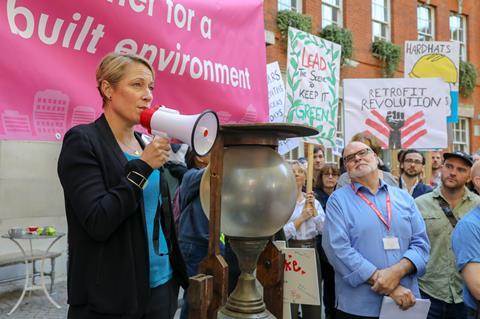Lack of agreed metrics on carbon savings from retaining components in projects is an important gap in industry knowledge, climate group claims

The built environment urgently needs a more consistent approach to measuring how much carbon is saved by reusing materials when demolishing and rebuilding projects, the UK Green Building Council has said.
The lack of an agreed method to measure and report how much carbon is saved by the reuse of materials such as steel and timber is “an important gap in industry knowledge”, the group added in a new report.
The UKGBC is among a number of groups including climate campaign Architects Declare which have argued that reusing materials from existing buildings, known as a circular economy, is essential if the construction industry is to achieve the government target of net zero carbon emissions by 2050.
Assessments of the amount of carbon emitted during the lifetime of a building are increasingly required, either through development strategies such as the London Plan, or through corporate climate targets.
But the report, entitled Insights on How Circular Economy Principles can Impact Carbon and Value, warns that current measurements of material reuse are “infrequent, inconsistent and difficult due to the lack of a common set of metrics and methods”.
>> Also read: Government’s policies will not hit net zero targets, UKGBC boss warns

The UKGBC looked at 18 case studies where materials were reused on projects, but said the amount of carbon saved was not always measured.
Out of the five case studies looked at in detail, three encountered issues measuring the carbon savings from retaining building elements because of a lack of data. These materials included cement and mechanical and electrical components.
Industry groups are currently working on several projects to improve the clarity and consistency of reporting carbon savings from material reuse. These include a forthcoming update to the RICS’ Whole Life Carbon Assessment for the Built Environment, due to be published next year, and work by the UKGBC circular economy forum to identify a set of metrics.
UKGBC chief executive Julie Hirogoyen said the circular economy represents an “enormous opportunity” for the built environment industry.
“Through the smart application of circular practices, significant carbon savings can be made across the entire lifecycle of a building, as well as delivering cost-benefits and providing opportunities to enhance social value,” she added.
Reusing materials is considered to save significant amounts of carbon in projects because it reduces the amount of transport and material production required.
The UKGBC’s Net Zero Carbon Roadmap, published last year, outlined the actions needed for the built environment to reach net zero by 2050, including much greater adoption of circular economy principles










No comments yet